Wondering how much it costs to change motorcycle tires and whether you’d be better off changing them on your own? It all depends on several factors – your budget, how much time you can spare, and how far is your nearest dealership.
The cost of changing motorcycle tires is usually somewhere between $50-$80 per tire depending on your area. It doesn’t include the new tire itself – just the change. Some dealerships offer cheaper tire changes if you buy the tires from them.
If you take the wheels off your bike yourself and bring them to the dealership, the motorcycle tire change cost will be a little less – around $20-$40 per tire.
A hidden cost of motorcycle tire changes is the time and distance to travel to your local dealer. If it’s nearby, that expense is minimal. If you have to travel for more than 50 miles, the cost adds up.![]()
Finally, the cost of changing motorcycle tires depends on the kind of shop you choose. Smaller, local shops tend to charge less than big, authorized dealers, and chain dealers offer better prices if you buy your tires from them.
Changing your tires at a local shop means you’ll get it done fast and professionally. If you’re not mechanically minded yourself, that’s the easiest and simplest solution, especially if your local dealer is nearby.
The disadvantages of changing your rubber at a local shop are the cost (authorized dealers may charge more than $80 per tire change). In addition, a dealer may push you to buy the tires they offer rather than the ones you want; finally, it’s not uncommon for workshops to scratch or damage the rims of your wheels.
If you run mousse inserts, that presents another challenge. Most industrial tire changers with a duck head system cannot handle mousse insert changes, which means the mechanic will need to do it manually – and, chances are, charge you more for the pleasure.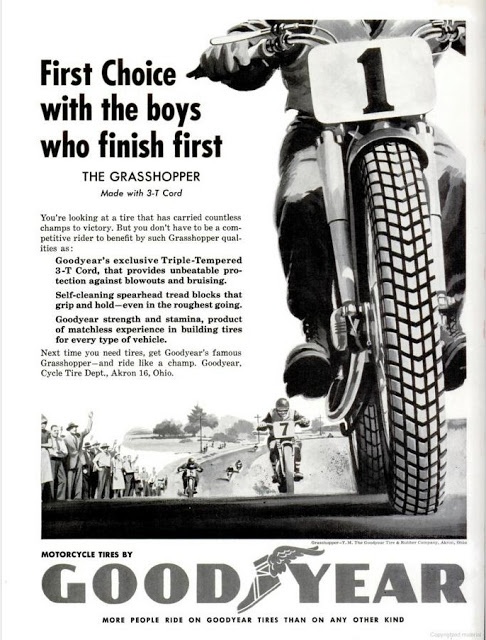
The cost of changing your own motorcycle tires is zero if you have the right tools. Motorcycle tire replacement isn’t rocket science, and you can learn to do this yourself fairly quickly. Stiff sidewall motorcycle tires are a little harder to change, but it can be done – especially if your garage is well-equipped.
Replacing your own motorcycle tires means freedom. You can do it whenever you need to without having to book an appointment and drive to the local shop, you can buy whichever tires you prefer, and it’s up to you to decide when you need new rubber.
Changing your own motorcycle tires is a great skill to possess. Not only you save cash, but you’ll also be able to fix a flat tire roadside instead of waiting for someone to come along and help. Finally, when you change them yourself, all you need to worry about is the cost of motorcycle tires rather than new rubber and the work to replace them.
If you don’t have a lot of experience, changing your own motorcycle tires can be a challenge for the first time. It takes several changes to master the skill, especially if you ride a motorcycle with stiff, hard tires that are usually a little more difficult to remove and mount.
Then, there’s the question of choosing the right motorcycle tire changer. If you’re just starting out, wrestling with your tires using just tire irons can be a nightmare, whereas a tire-changer might make the job much easier.
Replacing your own motorcycle tires can be learned, especially if you start off with the right tools. If you own a dirt or an adventure bike, the Rabaconda ADV Tire Changer is a fantastic solution: simple and easy to set up and use, this tool is designed to make tire changes almost effortless and fast, even if you don’t have a lot of experience.
For street, cruiser, touring, sport-touring, V-Twin, sport, and some adventure motorcycles, the best option is the Street Bike Tire Changer tool that’s adaptable to most wheel sizes and offers extra rim protection. Cast, forged, or wire-spoked wheels, single and double-sided swingarms – the Street Bike Tire Changer is capable of changing almost any tire, at zero cost.
The initial expense of getting a high-quality tire changer may seem a tad steep, but it will save you a good chunk of change in the long run and enable you to change your own tires whenever you need to. Hey, you might even earn a few gratitude beers from your friends if you help them change their tires, too - or perhaps charge a small fee for it!
As a rule of thumb, it costs about $20-$80 to change a motorcycle tire. If you take off the wheels and bring them into a shop you can expect to pay $20-$40 per wheel. But if you bring the whole bike into the shop be prepared to pay $40-$80 per wheel, in addition to the cost of the tires of course. Some dealerships may quote you much more, but don’t be ripped off!
If you take off the wheels and bring them into a shop you can expect to pay $20-$40 per wheel. But if you bring the whole bike into the shop be prepared to pay $40-$80 per wheel, in addition to the cost of the tires of course. Some dealerships may quote you much more, but don’t be ripped off!
If you want to learn more about motorcycle tire change costs, you are in the right place.
We at PowerSportsGuide have gathered the average prices as well as the cheapest solutions under one roof!
How much does it cost to change motorcycle tires?It’s safe to say that the cheapest way to change motorcycle tires would be if you do the work yourself. However, as you will see, this is not recommended for security reasons.
A reputable shop can not only professionally mount your tires, but they also balance the wheels with a special rebalancing machine.
Balancing the wheels is very important since only a slight weight difference can lead to vibration.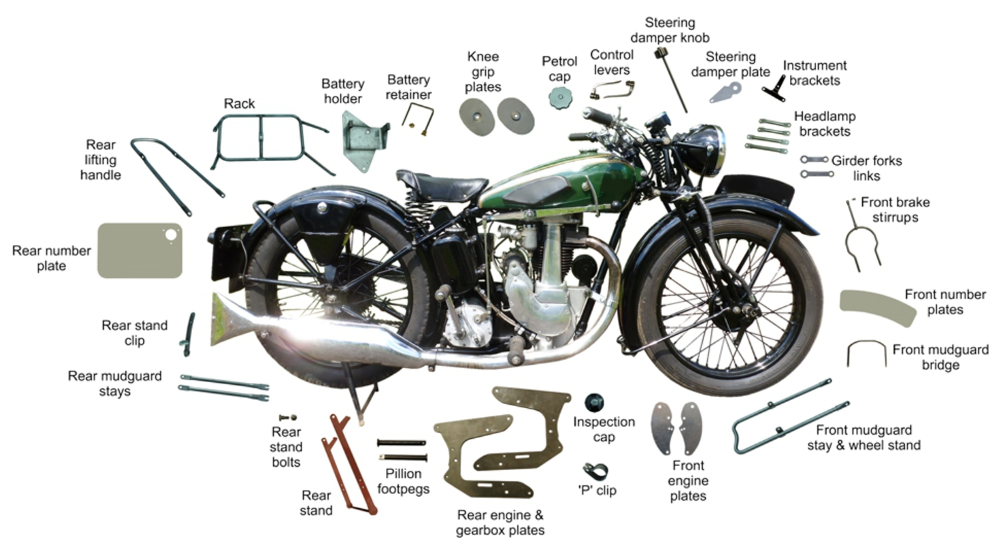 That’s why it’s recommended that you get the tire change done by a professional who can rebalance the wheels along with changing the tires.
That’s why it’s recommended that you get the tire change done by a professional who can rebalance the wheels along with changing the tires.
Moreover, many shops offer a discount or don’t even charge for the change if you buy the tires from them.
You can also keep your costs low if you pull the wheels off yourself and bring them into the shop. This way it will cost about $40-$80 to change a pair of motorcycle tires.
On the other hand, many riders simply prefer riding to a dealership or a local shop to get the tire change done. This is arguably the most convenient solution, but also the most expensive!
If you are also considering visiting a shop, it’s recommended that you shop around to find the best rates available. The labor costs vary widely depending on the size and location of shop.
As you may assume, you can expect the highest rates at authorized dealerships. It’s not uncommon for dealers to quote $150-$400 to change motorcycle tires!
In contrast, small local shops are significantly cheaper, as they usually charge $80-$160 for the entire job.
It’s also good to know that replacing the tire on the front wheel is always significantly cheaper than the rear, a 50% difference in price between the two wheels is not uncommon.
However, best practice is to replace both tires at the same time!
Can I change a motorcycle tire myself? – we get this question a lot and the answer is that it depends. Although it is possible to change the tires on your motorcycle at home, in most cases this is not recommended. Why?
When it comes to motorcycles, the primary consideration should always be safety.
And improperly mounted tires can be dangerous in many ways, so it’s not worth the risk of gambling with them! Contrary to popular belief, changing tires requires skill as well as some specialized tools.
Even if you can properly mount the tires, you always risk scratching the rims or damaging the new tires.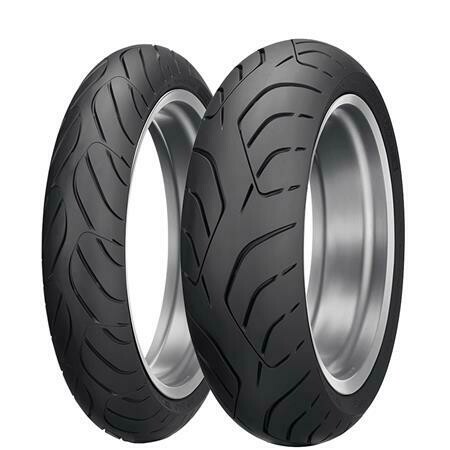
Additionally, a professional shop not only changes the tires, but their service typically includes the balancing, lining, setting the chains tight, and a test ride as well.
Although you can do all of these tasks yourself, it still takes time and effort. It may take hours just pulling the wheels off, mounting and inflating the tires, and finally balancing and replacing the wheels.
This is why best practice is to get it done by a tire shop. Let’s see where you can find one!
It’s safe to say that the majority of tire shops can change motorcycle tires, even dedicated auto tire shops. In most cases, it makes sense to visit a local shop rather than ride many miles to a dealership. What’s more, local shops are typically much cheaper as well! But to make sure they can handle the change it’s worth a phone call first.
What’s more, local shops are typically much cheaper as well! But to make sure they can handle the change it’s worth a phone call first.
Whether you can change a motorcycle tire on a car tire machine is strictly dependent on its design. While many older machines could change motorcycle tires without any issues, modern machines clamp on the rim and feature a rotating table. This means if you want to change a motorcycle tire on these machines you will likely need an adapter, which holds the wheel higher off the rotating table.
Unfortunately, many of the newest car tire machines can’t be used at all to change motorcycle tires. This is because some manufacturers don’t provide adapters for motorcycle wheels.
This is because some manufacturers don’t provide adapters for motorcycle wheels.
If you have access to a tire machine and are considering replacing the tires yourself, make sure to have somebody close by who is familiar with using the machine.
Operating a tire machine is not rocket science, but like any other power tool it can be dangerous in many ways. Doing it wrong can damage the tire or even the surface of the rim!
If you want to change the tires on your motorcycle you have four options:
DIY tire replacement: Even if this is the cheapest way to change the tires unless you’re an experienced mechanic it’s not recommended that you do it yourself. Keep in mind that doing it wrong can damage the tires or even the rims. Keeping safety in mind, best practice is that you leave it for professionals.
Remove the wheels: Many riders prefer pulling the wheels and bring into a local shop or a dealership, so you may want to consider this solution. This way, you can get much better rates while making sure that the tires are professionally replaced and balanced. If you bring the wheels in yourself, changing a pair of motorcycle tires typically costs $40-$80 in most tire shops.
This way, you can get much better rates while making sure that the tires are professionally replaced and balanced. If you bring the wheels in yourself, changing a pair of motorcycle tires typically costs $40-$80 in most tire shops.
Ride to a tire shop/dealership: The most convenient solution is arguably riding into a tire shop or a dealership to get the job done. The rates of smaller tire shops range from $40 up to $80 while dealerships can even quote $150-$400!
The rates vary widely depending on the size and the location of the shop, so it makes sense to shop around before making a decision!
Choosing tires for a motorcycle is not an easy task. Like the selection of equipment, tires should be selected based on the type of motorcycle, the nature of the ride. After determining the initial criteria, choose a rubber to find the best option available.
If you put sport tires on a sport bike, they will grip well in corners but wear out quickly.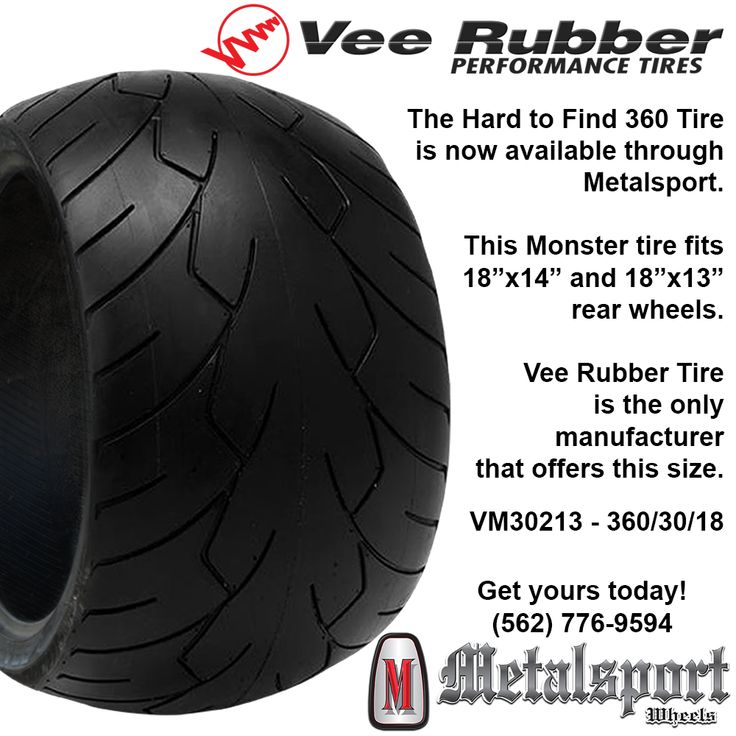 If you put ordinary touring tires in a sportbike, you can be very surprised by the handling of your motorcycle on the track. It's a good idea to use a tire with multiple compounds - then the hard center wears less on the track and the soft sides hold up better in the corners. nine0003
If you put ordinary touring tires in a sportbike, you can be very surprised by the handling of your motorcycle on the track. It's a good idea to use a tire with multiple compounds - then the hard center wears less on the track and the soft sides hold up better in the corners. nine0003
Tire type selection? There are no universal answers here, but there are useful tips that can help a lot.
Tires differ in structure, rubber compound, profile or tread pattern. Others differ in appearance - for example, a white rim. All these elements determine the purpose of the tires. That's where different types of motorcycle tires come from.
Whether sporty, racing, dynamic or classic, motorcyclists enjoy driving. However, each of these categories has different characteristics, which affects the driving style and the final choice. nine0003
Each tire has a number and letter marking with information about its size and permissible speed.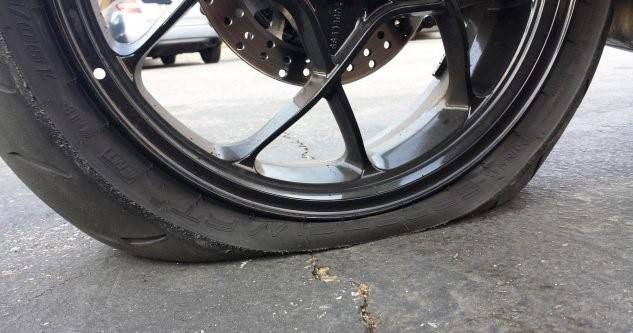 An approximate marking on a motorcycle tire may contain: 150 / 70-16 68 H.
An approximate marking on a motorcycle tire may contain: 150 / 70-16 68 H.
Example designation 150 / 70-16 68 H defines:
Race bikes are used on the track where the best performance and therefore the result is important. This applies to grip, stability and properties that determine the speed of acceleration. nine0003
The most common racing tires are slick (bald) or racing cut. The first are completely smooth, that is, without grooves and incisions. This solution is suitable for racing on dry pavement - due to maximum surface-to-surface contact. However, this does not apply to ordinary streets. Likewise, riding in rainy weather with these tires would definitely be a bad idea.
However, this does not apply to ordinary streets. Likewise, riding in rainy weather with these tires would definitely be a bad idea.
Many models of racing tires can only be used on the track. They are marked with the NHS (Not For Highway Service) abbreviation, which means that they are not approved for driving on public roads. nine0003
Sports tires are suitable for racing and competition. The chemical composition is optimized in terms of acceleration, top speed, grip, effective and safe braking even in emergency situations. This type of motorcycle tire is not used for daily driving and on public roads.
Examples: Dunlop Sportmax GP Racer, Metzeler Racetec INT, Metzeler Racetec RR, Pirelli Diablo Supercorsa. nine0003
A separate class of racing tires are rain racing tires. Their task is to remove water from the contact patch, including when the motorcycle is tilted, and the maximum level of grip on wet asphalt.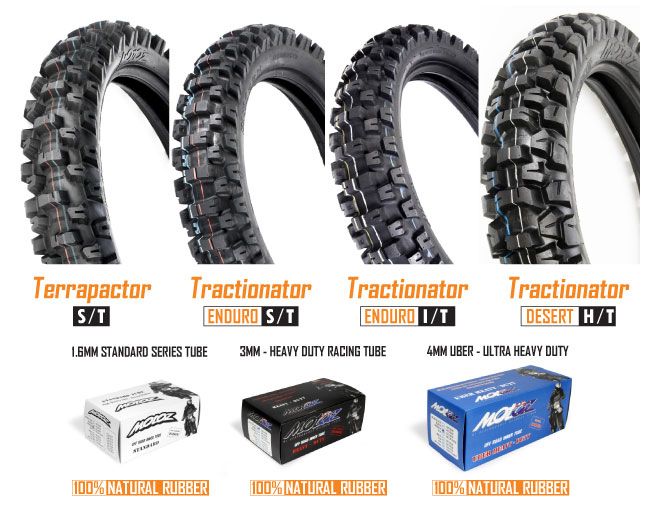 When driving on dry roads, such tires are subject to rapid wear, as they have a very soft composition.
When driving on dry roads, such tires are subject to rapid wear, as they have a very soft composition.
Examples: Pirelli Diablo Rain, Metzeler Racetec Rain.
Touring motorcycles are large motorcycles designed for long journeys. They use special rubber compounds that affect grip and steering precision. Also available are treads that keep the tires reliable even in deteriorating conditions.
For this type of rubber, its resource is of particular importance, since it is precisely such rubber that is most often used by motorcycle travelers in their many thousands of runs around cities and countries. In addition to long routes with different quality of coverage, on which the tourist tire must be equally predictable and safe, long trips are usually associated with a large mass of transported belongings, without which the life of a motorcycle tourist becomes dull and bleak. And the tourist motorcycles themselves, in terms of their curb weight, are increasingly approaching diesel locomotives.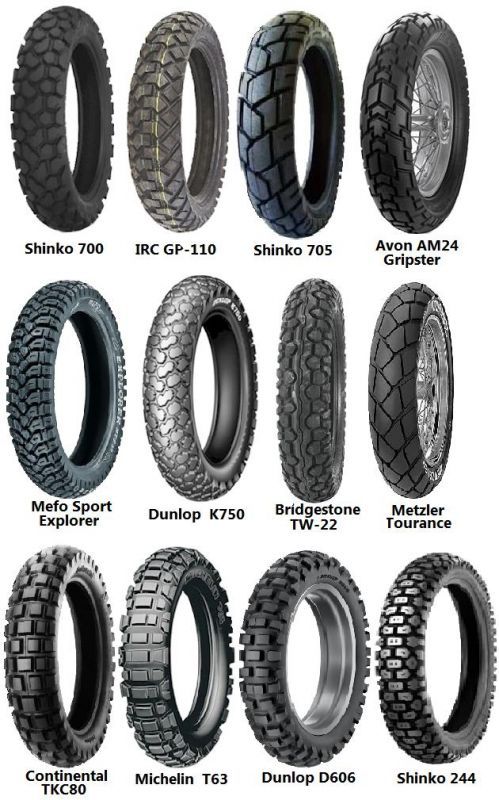 nine0003
nine0003
Road-tourist tires must withstand long runs, withstand high loads well. At the same time, the requirements for the quality of adhesion give way to high predictability and a "motorcycle feel" that allows even an inexperienced motorcyclist to feel and stop the development of slips and drifts at an early stage. The main task is not to pass the route at the highest speed, but to reach the final destination in the safest possible mode, while maintaining control over the motorcycle in any weather. nine0003
Accordingly, the grooves for water drainage in such tires are more developed. And some models are specially optimized to maintain performance on wet roads. The resource of such tires ranges up to 20,000 km. Road touring tires are suitable for the city and travel on road and touring motorcycles. Moreover, for the latter, given their large mass, special “reinforced” versions of tires are sometimes produced.
Examples: Dunlop TT900 GT, Mitas MC50 , Metzeler Tourance Next, Metzeler Lasertec, Michelin Pilot Activ
This includes everything that has already exceeded the simple city treads, but has not grown out of the malice of the pattern to an off-road character.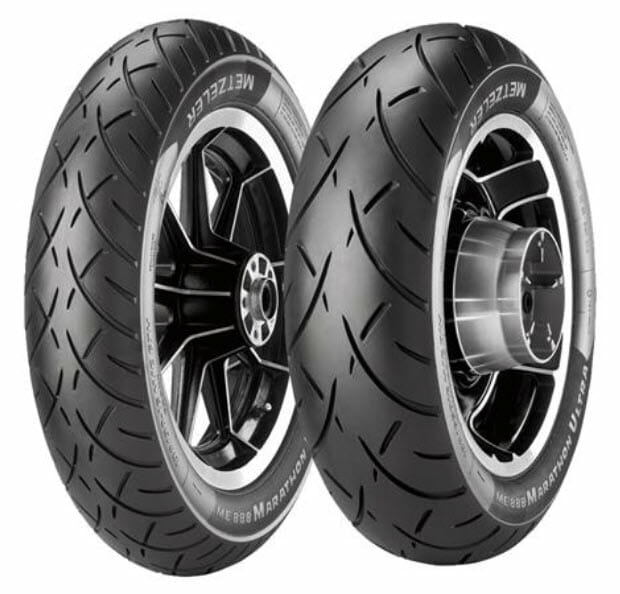 Dual purpose tires designed specifically for those who love hybrid driving style. They let you ride your motorcycle to work on the weekdays and hit the trails on the weekends.
Dual purpose tires designed specifically for those who love hybrid driving style. They let you ride your motorcycle to work on the weekdays and hit the trails on the weekends.
For motorcyclists who prefer different riding styles, there is nothing better than the ability to conquer roads and off-road. Whether your motorcycle is a city bike or a touring bike, with dual-purpose tires, you no longer have to choose one style of riding. nine0003
Tourist and all-terrain options are distinguished by increased endurance, as they withstand the load of not only a motorcycle with a pilot, but also a bunch of accessories and things necessary for the journey. The tread changes to a clear pattern that can equally successfully help the motorcycle on simple roads and beyond.
Such rubber is most often put on enduro-touring motorcycles, scramblers and not small-capacity dual-purpose motorcycles (soft enduro for every day). nine0003
Such a tire provides a sufficient grip patch with an asphalt surface, the grooves effectively drain water, and the checker tread provides good traction outside the asphalt (on the ground, in sand, mud, gravel).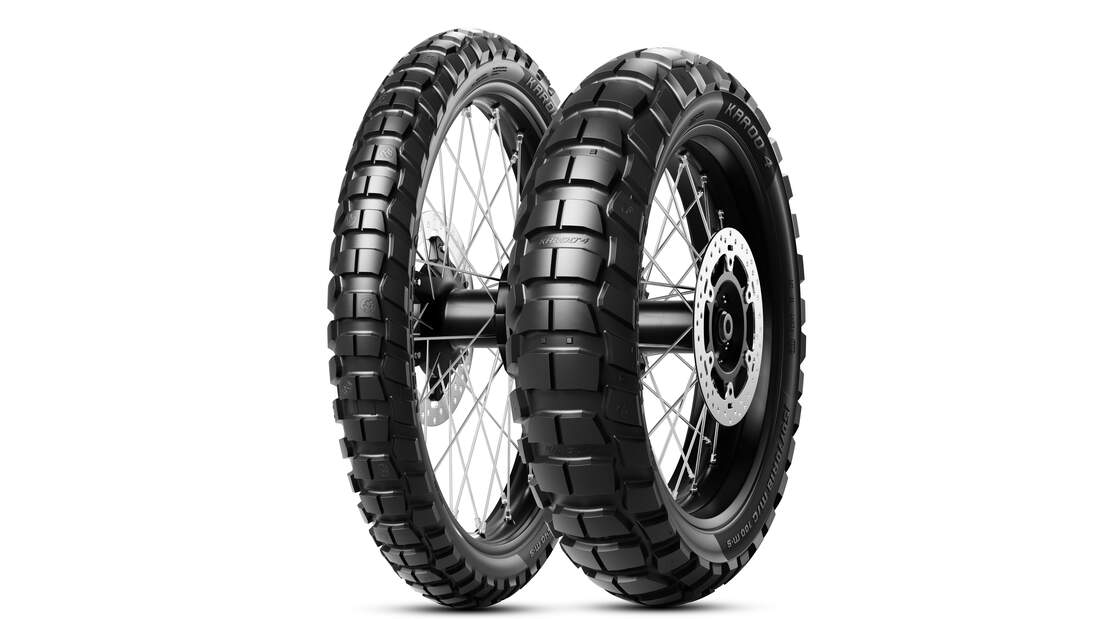
Examples: Metzeler Tourance, Mitas E-08, Mitas E-07, Metzeler Tourance.
Rubber for off-road motorsport is divided into two main types - for motocross, enduro. For each discipline, tires are produced for both professional sports and amateur use. The latter are more versatile, and very often manufacturers position outdated rubber models for “big” sports as tires for amateur driving, which remain popular among amateurs. Cross-country tires also require a tire tow bar so that during hard acceleration or braking, the tire does not rotate on the rim and the nipple (nipple) comes off. Used mainly on front and rear wheels, but more often required on the rear wheel due to the high load on the rubber. nine0003
Rubber is made not only for a specific discipline, but also for operating conditions. Many factors are taken into account - the type of soil on the track, the characteristics of weather conditions, certain goals, for example, speed and roll, or vice versa, the maximum hook.
An important difference between off-road tires and tires for other motorcycle disciplines is that such rubber falls into the category of consumables, manufacturers recommend regularly updating a set of tires. Often at the beginning of each season, athletes are forced to change tires due to rapid wear. This is due to the fact that off-road rubber has a direct sports purpose - its task is to provide reliable grip at maximum speed while passing the track, so manufacturers think about durability and long service life last. nine0003
What is a compound?
It will not be a secret for anyone that the times of synthetic, and even more so natural rubber, are long gone.
Conventional rubber has been replaced by a compound - a synthetic alloy of various monomers and polymers, which has a much higher wear resistance and, most importantly, certain properties.
Thanks to the unique properties, manufacturers have been able to produce specialized off-road tires that correspond to a certain type of soil on the track. nine0003
nine0003
Cross, Motocross tires
Motocross is the most dynamic discipline of extreme motorsport. Athlete, equipment and, in particular, tires of a motorcycle are subjected to severe loads during the entire race. That is why cross-country tires must be hardy, reliable and aggressive.
These characteristics are reflected in the use of a hard cord (steel base) for maximum durability, an aggressive tread pattern with pronounced elements for better traction, and a special compound that is selected depending on the type of surface of a particular route. nine0003
For hard, dry ground, use tires with wide lugs (to increase bike control) and a flexible compound that enhances grip on the track. For soft, loose ground, tires with a harder compound are used. A similar type of rubber is used in freestyle motocross in order to extend the life of tires, because. rubber is strongly erased on the hard canvas of iron eps and is selected depending on the type of soil on a particular track.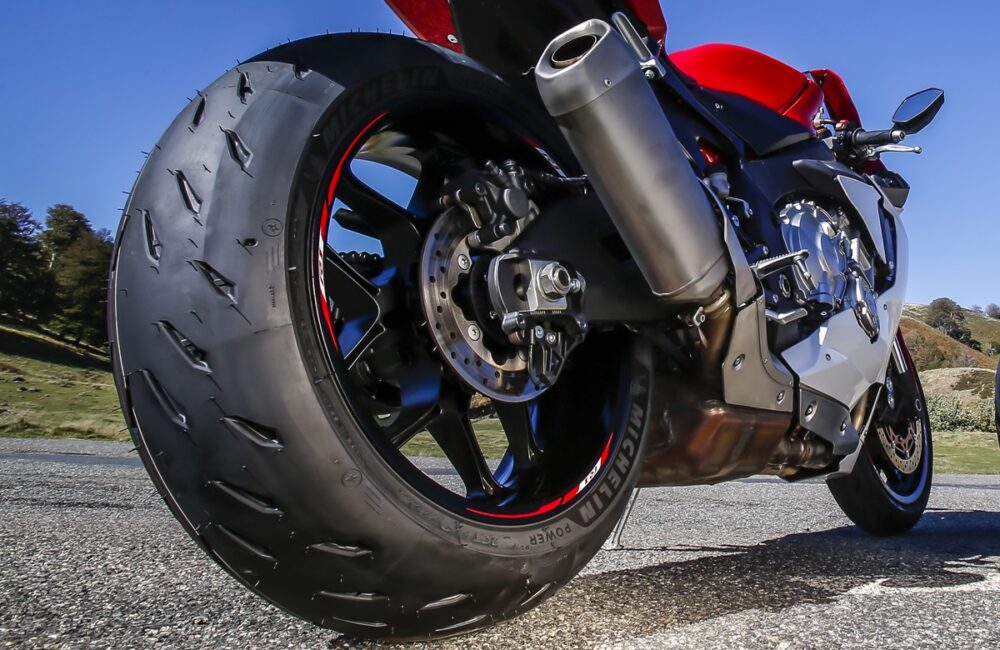
The rule generally applies: the softer the jumps. nine0003
The pressure ranges from 1.5 to 3 atmospheres covering the track - the higher the pressure. But it also happens the other way around - for example, in motofreestyle, riders prefer to inflate tires to a “stone” state for maximum roll and reduce the risk of chamber breakdown in the event of a hard landing.
Examples: Mitas C-19, Mitas C-21, Mitas C-10 Country Cross, Dunlop Geomax MX12 Sand, Metzeler MC360, Pirelli Scorpion MX Extra X -enduro
Unlike motocross, enduro and hard enduro courses are littered with various obstacles such as logs, roots, loose pebbles, truck tires, river fords, and even whole rocks. To overcome such a “tin”, special tires are used that combine the advantages of cross-country rubber and trial tires.
Enduro tires use a softer, extra wide cord and a sticky, highly elastic compound that provides maximum grip on any surface. According to the regulations of international competitions FIM, the tread pattern of enduro tires has a height limit, so enduro rubber has a less aggressive tread than cross-country tires. nine0003
According to the regulations of international competitions FIM, the tread pattern of enduro tires has a height limit, so enduro rubber has a less aggressive tread than cross-country tires. nine0003
In the enduro discipline, tubeless tires are more often used, filled with a special mousse or tubes system instead of air in the chambers, as is the case with motocross rubber. This solution allows you to use the minimum pressure in the tires without the risk of getting a breakdown or slipping of the tire on the rims during the race.
Examples: Mitas E-09, Mitas EF-07, Mitas XT-754
In classic motorcycles, the main goal is to get quality grip. Classic motorcycles have weaker engines and slower speeds and do not require special radial designs for high performance. These are safe tires with a simple design. nine0216
Diagonal tires are suitable for cruiser class motorcycles. Their sidewalls resist loads and impacts better, a heavily loaded motorcycle with a passenger on board is not a problem for such tires.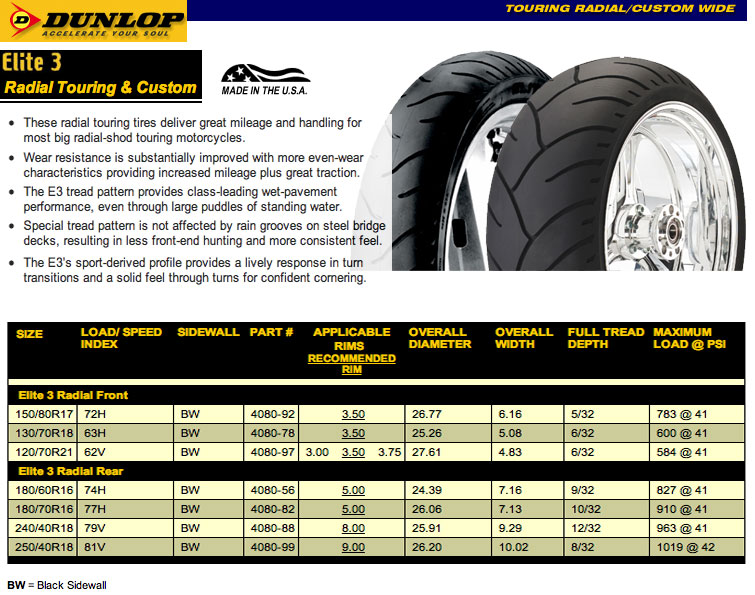 For powerful and fast power cruisers such as the Yamaha V-MAX II and Harley Davidson V-Rod, radial tires are more suitable. Their sidewalls are not as strong, so the height of such tires, as a rule, is much less. They are less subject to internal heating and wear during movement, especially at high speeds. nine0003
For powerful and fast power cruisers such as the Yamaha V-MAX II and Harley Davidson V-Rod, radial tires are more suitable. Their sidewalls are not as strong, so the height of such tires, as a rule, is much less. They are less subject to internal heating and wear during movement, especially at high speeds. nine0003
Examples: Metzeler ME888 Marathon, Michelin Commander III Cruiser.
Tires are made from synthetic rubber (a mixture of petroleum as well as chemicals such as sulfur, carbon black and silicone). They are assembled in stages, starting with the assembly of the cord and belt construction, after which the rubber is applied and molded.
In order for the trip to be as safe as possible, and the choice of tires for a motorcycle to be accurate, it is worth knowing what is hidden inside motorcycle tires. nine0003
The most important in motorcycle tire design are:
1. Cord.
Cord.
2. Board.
3. Protector.
4. Side walls.
The cord, called the carcass, is made of a very strong material whose task is to give the tire the correct shape and remove bumps or stress. The carcass of the tire consists of two or more layers of textile cord (viscose, nylon, polyester) that intersect at certain angles. nine0003
The side walls, being the thinnest element, are very resistant to deformation.
The bead is the part of the tire that connects to the wheel. It is usually steel wire heavily coated with rubber. The bead fits snugly against the wheel to prevent rotational slip of the wheel in the tire.
The tread is the part you see when you choose your tire. For the most part, slicker tires perform better on smooth, dry surfaces, while fatter tires perform better off-road. nine0216 The protector is responsible for the traction properties of the motorcycle and the removal of water, sand and other contaminants.
Sidewall - The area of a tire that connects the tread and bead. This is the part of the tire we talk about when we talk about height, profile or aspect ratio. Generally, a shorter sidewall has stiffer sidewalls that tend to flex less. For the rider, this means better handling and cornering, worse shock absorption, and a more difficult setup. nine0003
The markings can tell a lot of information, such as what maximum speed the tire should run, how much weight it can carry, direction of rotation (which is indicated by most tires), when the tire was made, tire size.
Metric tire size example: 180/70R-16.
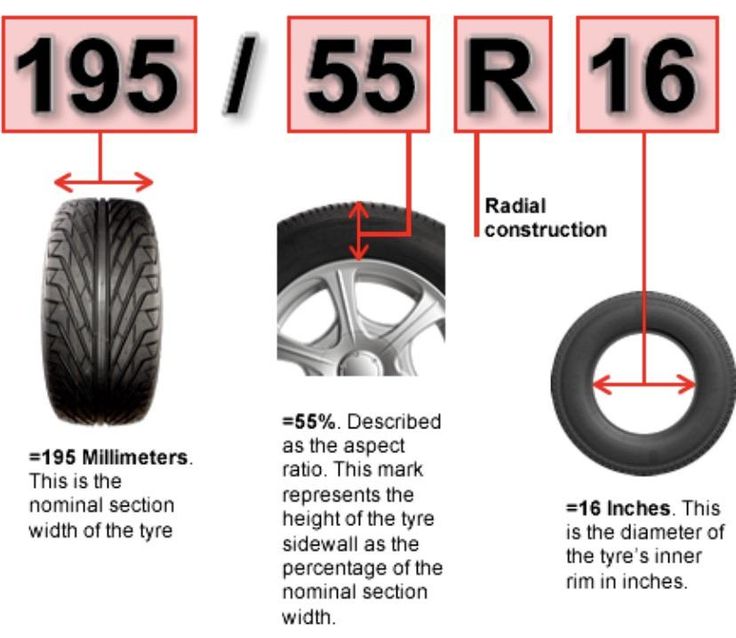 In this case, the rim size is 16 inches in diameter.
In this case, the rim size is 16 inches in diameter.
This is the alphanumeric sequence you see. Example: MU85B16. nine0003
Tires tend to wear unevenly over the entire area most of the time. This is due to insufficient air pressure, suspension settings and tire stress. There are many things you can do to take care of your tires, but the most important thing is spinning them. nine0003
Some tires have a specific direction of rotation to improve wet grip and optimize noise emissions. For tires with a directional tread pattern, the direction of rotation is indicated by an arrow on the side of the tire.
For tires with a directional tread pattern, the direction of rotation is indicated by an arrow on the side of the tire.
To optimize tire performance, follow manufacturer's recommendations for changing front and rear tires, always turning tires in the direction indicated on the tire surface. Do not interchange front and rear tires without observing the markings as this may result in poor tire performance and loss of traction. nine0003
The front wheel on a motorcycle is usually narrower and has a less aggressive tread pattern. The front rim handles most of the bike's braking and is designed to optimize steering.
The rear tire carries most of the motorcycle's weight, as well as rider and passenger weight. The rear tire is designed to carry heavy loads and also withstand the force exerted during acceleration. They have a stronger construction than the front tires and have more aggressive tread to optimize traction. nine0003
These tires have a special marking that indicates the ideal direction of rotation.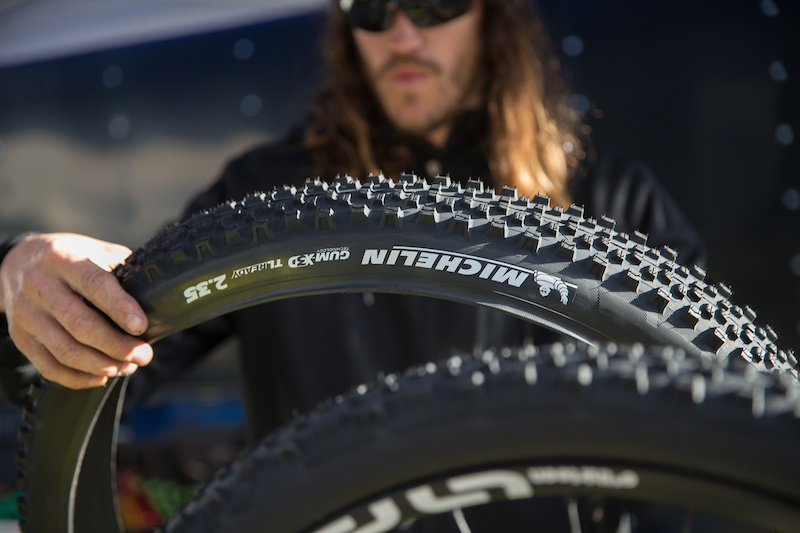 If the motorcycle tire is mounted against the direction of rotation, it can seriously affect the handling characteristics as well as the ability to grip the road surface. Moreover, improper installation may cause an accident.
If the motorcycle tire is mounted against the direction of rotation, it can seriously affect the handling characteristics as well as the ability to grip the road surface. Moreover, improper installation may cause an accident.
TL is a tubeless tyre. TT stands for tube type, intended for camera use. nine0003
Most motorcycles are now equipped with tubeless tires. Tube tires are used in the simplest and cheapest motorcycles, and those designed for long trips. The advantage of tube tires is the ability to continue driving even with a small breakdown and, possibly, replace a damaged tube yourself.
However, as a rule, tubular wheels are more problematic and less safe to use, because even the smallest puncture of the inner tube results in an almost instantaneous loss of pressure in the wheel. Tubeless tyres, more expensive to manufacture and require more precision in assembly, but safer - whatever gets hit usually stays in them and pressure loss is much slower. nine0003
nine0003
Buying new motorcycle tires is a real challenge, especially when it comes to choosing the best option. Rubber should be chosen as scrupulously as spare parts for your steel horse. Like many other motorcycle components, tires have their own markings and codes, and so do tires. It is worth knowing the symbols that are on motorcycle tires.
An important symbol by which you can read important information for the user is a dash. A dash ("-") in the index of a motorcycle tire indicates that it is a diagonal tire. If there was a "B" in its place, then it would be a diagonal tire with a belt, and when the "R" is a radial tire. Additional markings that can be found on motorcycle tires are the letters "TT", which says that we are dealing with tires that require a tube, while "TL" (TubeLess) is a tubeless tire. nine0003
You can often find additional markings:
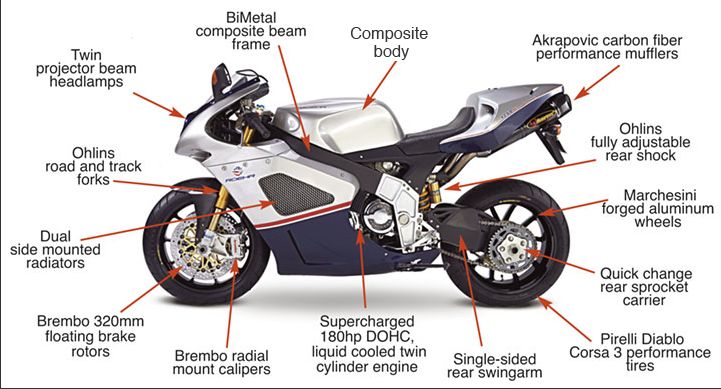 Tires smaller than 13" are not manufactured with this feature.
Tires smaller than 13" are not manufactured with this feature. Rigidity designation on motorcycle tires:
Green is soft. Tires for driving on soft ground.
Yellow is medium.
Red is tough. For hard ground.
Thanks to the “DOT” marking, we can see the date of manufacture of the tires, the manufacturer and the plant in which they were made. At the end of each such description there are four numbers, for example 1819. This means that the tires were produced in the 18th week of 2019of the year. Three digits means that the tire was produced before 2000. In this case, the first two digits indicate the week, and the last digit indicates the year. The presence of the DOT marking on tires informs that this set of tires meets the standards.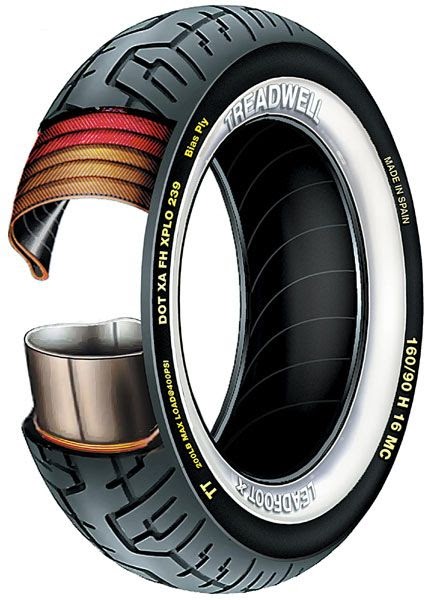
Depending on the intensity of motorcycle riding, tires should be changed every two to three seasons. Want to save money on tires? There is an option to buy used tires. But how good is this, a safe idea? nine0003
Don't invest in motorcycle tires. Each driver has a different driving style and different dynamics, which means that the tires are subjected to different stresses. This affects not only the condition of the tread, but also the general condition of the rubber, which is not visible at first glance. In addition, such a kit will have to be changed faster, and instead of investments, we have a new expense.
Worn motorcycle tires often go through most of their life cycle. If a set of new tires is enough for two, three or even four seasons, then in the case of old tires, further operation due to aging processes often becomes impossible after a year. nine0003
Used motorcycle tires are dangerous! The motorcyclist risks driving safety. After all, he does not know the technical condition of the tire and cannot accurately determine whether it was seriously damaged. Every owner of two-wheeled transport should keep this in mind every time he buys tires for a motorcycle.
After all, he does not know the technical condition of the tire and cannot accurately determine whether it was seriously damaged. Every owner of two-wheeled transport should keep this in mind every time he buys tires for a motorcycle.
It is recommended that you regularly check your motorcycle tire pressure with a pressure gauge before you ride. If the motorcycle is running, wait about 3 hours after turning off the engine. This is important because as the temperature rises, the pressure in the motorcycle tires increases, and the factory values are indicated for cold wheels. nine0003
The optimal level of fuel combustion is achieved at the values recommended by the manufacturer. Low pressure in motorcycle tires leads to intensive wear of the tread. It is difficult to say unequivocally how many atmospheres should be in motorcycle tires. This information is in the vehicle owner's manual. This figure is different for each motorcycle. By the way, it is very convenient to use a compressor instead of a pump.
By the way, it is very convenient to use a compressor instead of a pump.
Consequences of too high pressure
Excessive tire pressure on a motorcycle reduces the contact area of the tire with the road and thus the grip on the ground. This has a significant impact on security. When there is too much air in the tires, driving comfort is reduced.
Consequences of too low pressure
Too low air level causes excessive heating of the rubber. Then it becomes less resistant to damage, its structure may be deformed due to the direct impact of a large weight. This also affects the stability of the motorcycle, driving accuracy. nine0003
Low pressure tires are used on sports tracks. Warming up the tire is recommended here, as this provides better grip on the ground.
Recommended pressure:
Motorcyclists should pay special attention to new tires for their cars.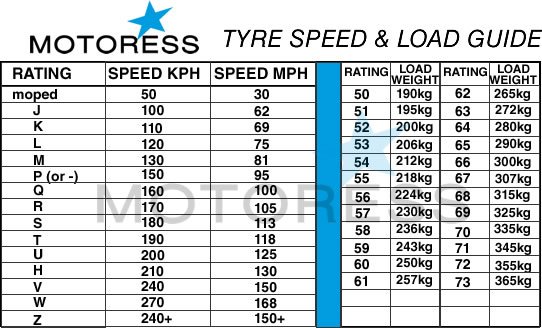 They usually have much higher requirements for traction than car drivers. The most experienced pilots know that running in new tires is necessary and affects traction during the first few hundred kilometers. nine0003
They usually have much higher requirements for traction than car drivers. The most experienced pilots know that running in new tires is necessary and affects traction during the first few hundred kilometers. nine0003
Tire manufacturers advise motorcyclists to ride carefully for at least the first 150-200 km on new tires. Motorcyclists should not brake hard, accelerate hard, or turn sharply.
A smooth ride for the first 200km allows the rider to get used to the tires and their feel, as well as getting rid of the chemicals on the rubber surface. After running in, check the tires for uneven wear.
Tires wear out over time and need to be replaced. Based on their personal riding style preferences, motorcycle tire wear will vary from rider to rider. Typically rear tires begin to flex, losing their rounded profile as the center of the tread wears faster than the sidewall. Front tires usually wear more evenly across the tread, but jagged wear, known as bowl wear, may begin to show.
Check your tires for adequate tread depth. When a tire is worn on the built-in indicators with a tread groove depth of 1/32 inch (0.8 mm) or less, or the tire cord or carcass is exposed. nine0003
Also inspect the tires for uneven wear. Wear on one side of the tread or flat spots on the tread may indicate a problem with the machine or motorcycle.
Each tire manufacturer recommends different mileage for tire replacement. On a motorcycle that mostly rides on pavement and good quality roads, you can change tires every 10,000 kilometers. A motorcycle that constantly rides off-road and is constantly exposed to severe damage, tires are changed every 4000 kilometers. nine0003
It is recommended to rotate the tires as soon as you notice a difference in wear between the front and rear wheels. But before rotating, make sure that this wear is not caused by negligence or mechanical part.
Tires in poor condition can ruin the performance of your motorcycle and even endanger your or your passenger's safety.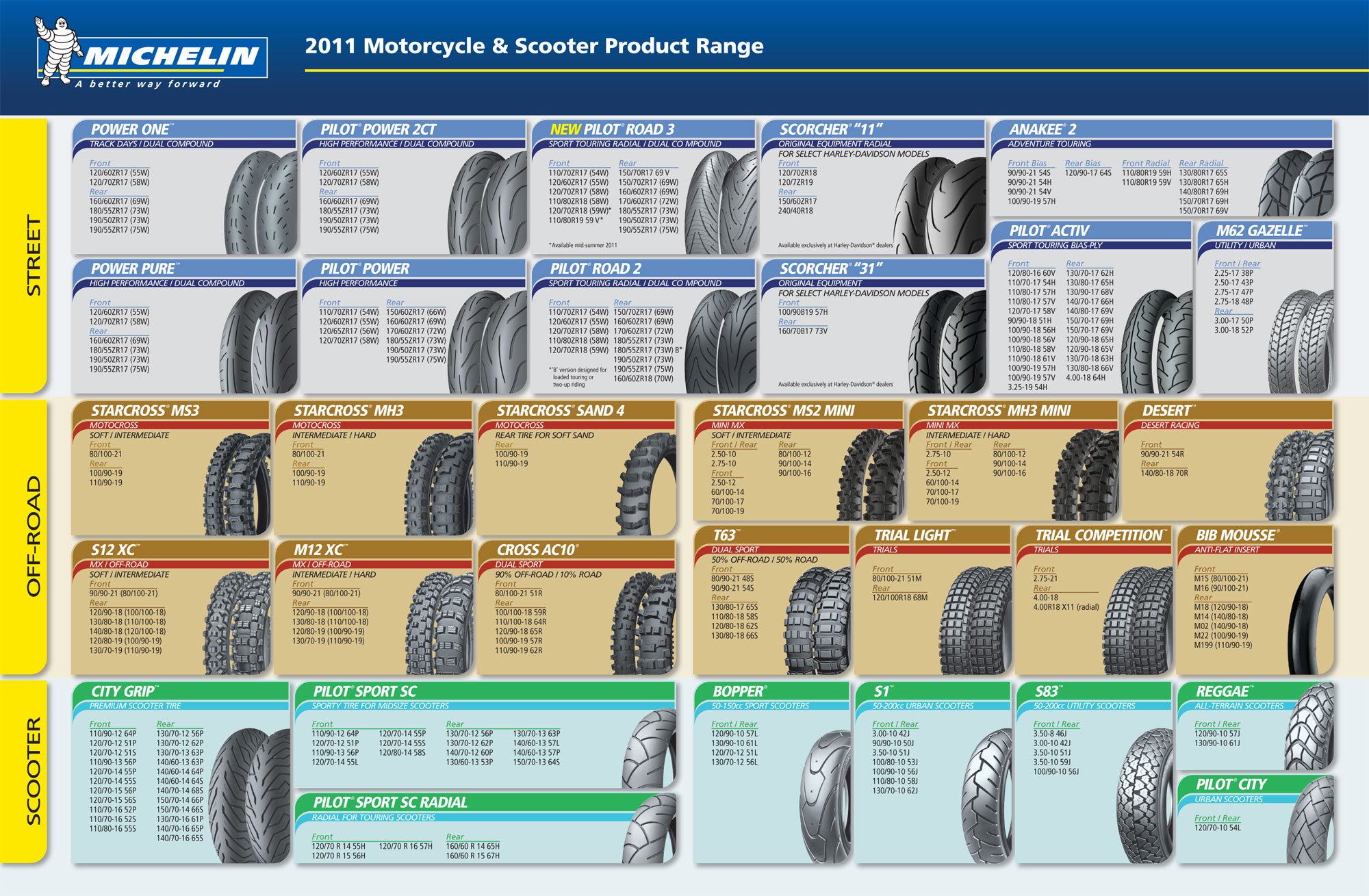 It is recommended to check weekly: nine0003
It is recommended to check weekly: nine0003
When your tires are worn out and become dangerous, you will feel the warning signs while riding a motorcycle. If your motorcycle starts to wobble. If your motorcycle starts to vibrate, makes a strange sound or becomes unstable, this is an indication that the sidewall of your tires is too worn or delaminate. nine0003
It is possible, but there is no guarantee that the rubber will work properly. Such activities require skilled workers to produce a tubeless rim from a spoked wheel. It's better to switch to tubeless alloys, depending on your requirements and the bike.
Tubes are not installed in tubeless tires. The disc of a tubeless wheel is not designed for the installation of cameras.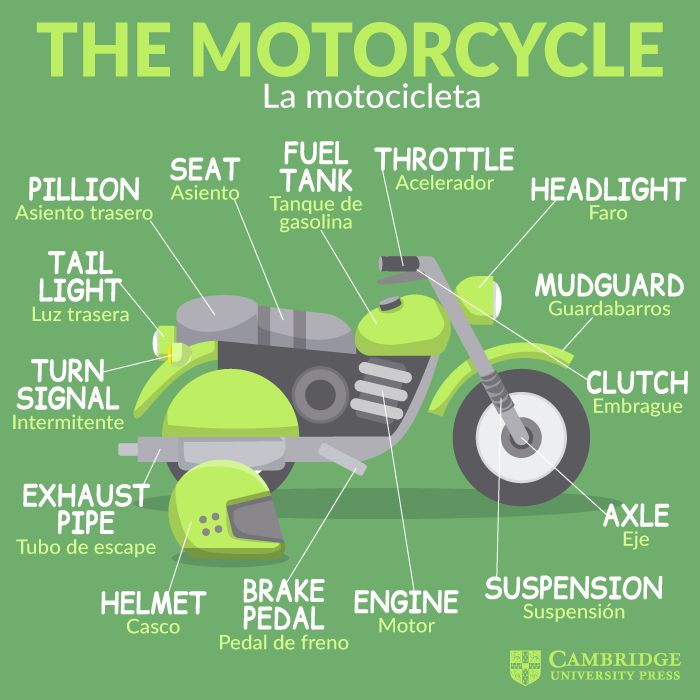 The so-called "nipple" of the camera will dangle in the place where the tubeless disc is attached, and in the end it will simply come off. A tubeless tire has less space and the installed tube will not be able to straighten out, air bubbles will appear, which will affect the balance and handling. nine0003
The so-called "nipple" of the camera will dangle in the place where the tubeless disc is attached, and in the end it will simply come off. A tubeless tire has less space and the installed tube will not be able to straighten out, air bubbles will appear, which will affect the balance and handling. nine0003
You can fit an old inner tube into a new tire and save money. However, for safety reasons, it is extremely important to have a suitable tube under the tire. Tubes and tires are clearly labeled for size, and the tube must be the same size as the tire, such as a 14" tube on a 14" tire.
Racing tires have a smooth tread pattern that is very efficient in motorsports. The smooth tread provides the maximum contact area with the asphalt, resulting in better traction, better braking and acceleration. nine0003
Rubber for the city must have a tread of at least 16 mm. Racing is not allowed for city driving.
Motorcycle tire manufacturers say you can't mix tires from different brands. This is not a sales tactic, tires are developed in pairs, traction and handling are determined by testing both at the same time.
Modern motorcycle tires are durable and efficient to work in all conditions. However, like any mechanical part of a motorcycle, tire life depends on external factors. nine0003
To ensure that the tire does not lose its qualities ahead of time, some steps must be taken:
Optimum air pressure maintenance:
Tire pressure control is essential to maintain tire performance and to maintain motorcycle fuel efficiency.
For optimum pressure follow these steps:
1. Maintain air pressure at the level recommended by the motorcycle manufacturer. nine0003
2. Check your motorcycle tire pressure at least once a week.
3. Inflate your tires in the morning as the air is cold and will expand even better.
Check tire tread regularly
Checking the tread is a common way to determine what condition a motorcycle tire is in. If the wear is above the recommended level, they must be replaced.
Avoid sudden driving maneuvers
While driving, avoid sudden braking and rapid acceleration. It damages the engine, clutch, brakes, and tires. When braking hard, the tires slide, which burns the rubber and damages the tread. This places additional and excessive stress on motorcycle tires.
Park the motorcycle in the shade
It is not recommended to park the motorcycle in direct sunlight as hot and harmful sunlight can damage the tires. The consequence of this is the formation of cracks on the sidewalls of the tires. nine0003
Clean tires with mild soap and water
When washing your motorcycle, clean motorcycle tires with mild soap and water. Chemicals and greasy solutions can remove the natural oils from the rubber, which is necessary to maintain traction on both wet and dry surfaces.
Chemicals and greasy solutions can remove the natural oils from the rubber, which is necessary to maintain traction on both wet and dry surfaces.
These tips will help extend the life of your tires. Tire repair is carried out with the help of special paddles, and emergency repairs - with a tire repair kit. nine0003
Mitas tires are supplied for original equipment of aircraft of Czech and Slovak manufacturers. In addition, they are supplied to companies manufacturing aircraft wheels in the Czech Republic, Germany and other countries. Customer orders for Mitas aircraft tires come from Europe, Africa, America, Asia, Australia and the Pacific.
Mitas aircraft tires suitable for civilian platforms , i. e. ultra-light, light, sports, including turboprop aircraft, scheduled and charter, as well as light military fighters and military training aircraft.
e. ultra-light, light, sports, including turboprop aircraft, scheduled and charter, as well as light military fighters and military training aircraft.
*Illustration description: Tire size 6.50-10; Aircraft L 410 NG; Aircraft Ae 270; Aircraft L-159; Cessna 414 Chancellor
All new Mitas commercial aviation tires are EASA approved (European Aviation Safety Agency), which is guaranteed by the Civil Aviation Authority in the Czech Republic. The production and development of aircraft tires, including manufacturing plants, is subject to regulation by the Civil Aviation Authority.
Accuracy and adherence to work procedures are critical to the production of Mitas aircraft tires. We place very strict quality requirements on the raw materials used, semi-finished products and the final product itself. As a standard, the control of the physical and mechanical characteristics of the produced tires and their testing in certified laboratories is applied.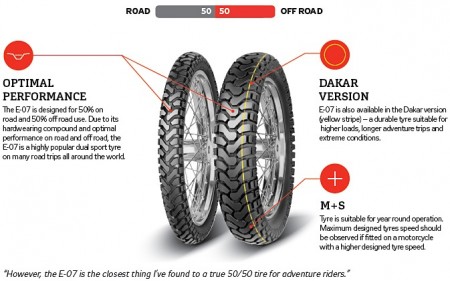 nine0003
nine0003
More information can be obtained by e-mail. e-mail: [email protected]
The Mitas brand prides itself on the superior quality of its aircraft tires, which our customers value as first class, with exceptional performance and long service life.
Customer rating: Due to the exceptional quality and excellent technical parameters, we use Mitas brand tires on all L-159 fightersand most of the L-39 trainers in Europe, Asia, America and the USA. We are preparing to equip the new advanced L-39NG training platforms with these tires.
The chief designer stated: Mitas aircraft tires are a reliable product. They are installed on the chassis of all L 410 models supplied worldwide. L 410 aircraft with Mitas tires operate on runways with a wide variety of surfaces, including unpaved runways, in various climatic conditions. Users appreciate the great reliability and long life of Mitas tires in the toughest working conditions.